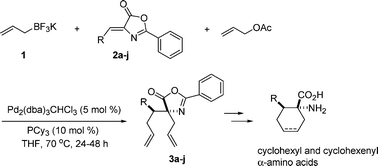Amphiphilic allylation of arylidene-1,3-oxazol-5(4H)-one using bis-π-allylpalladium complexes: an approach to synthesis of cyclohexyl and cyclohexenyl α-amino acids†
Abstract
An efficient method for synthesis of

* Corresponding authors
a
Department of Chemistry, Faculty of Science, University of Tanta, 31527-Tanta, Egypt
E-mail:
genadyafaf@yahoo.com
b
Department of Chemistry, Faculty of Science, Gakushuin University, 1-5-1 Mejiro, Toshima-ku, Tokyo 171-8588, Japan
E-mail:
hiroyuki.nakamura@gakushuin.ac.jp
Fax: +81-3-5992-1029
An efficient method for synthesis of

 Please wait while we load your content...
Something went wrong. Try again?
Please wait while we load your content...
Something went wrong. Try again?
A. R. Genady and H. Nakamura, Org. Biomol. Chem., 2011, 9, 7180 DOI: 10.1039/C1OB05952A
To request permission to reproduce material from this article, please go to the Copyright Clearance Center request page.
If you are an author contributing to an RSC publication, you do not need to request permission provided correct acknowledgement is given.
If you are the author of this article, you do not need to request permission to reproduce figures and diagrams provided correct acknowledgement is given. If you want to reproduce the whole article in a third-party publication (excluding your thesis/dissertation for which permission is not required) please go to the Copyright Clearance Center request page.
Read more about how to correctly acknowledge RSC content.
 Fetching data from CrossRef.
Fetching data from CrossRef.
This may take some time to load.
Loading related content
